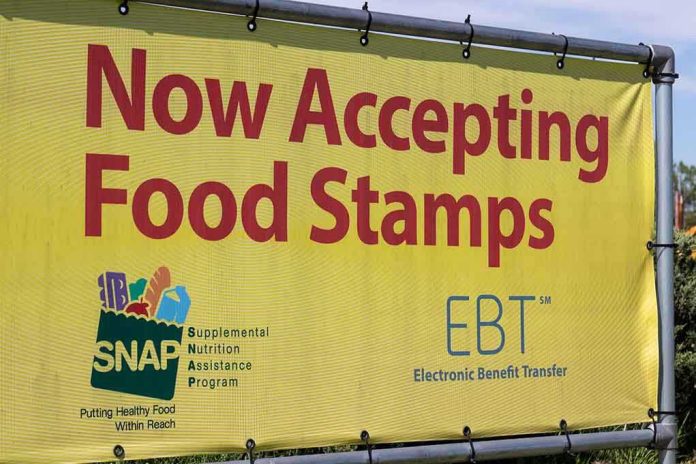
If you believe the headlines, America’s food aid program is being raided by illegal immigrants—but the real story is who’s actually losing their last lifeline, and why the facts don’t match the furor.
Story Snapshot
- Undocumented immigrants have been largely ineligible for SNAP for decades, but new laws now squeeze out many legal humanitarian immigrants too.
- Claims of widespread “illegal alien” abuse of SNAP persist, despite strict federal verification systems and scant supporting evidence.
- The 2025 One Big Beautiful Bill Act (OBBB) removed thousands of legal immigrants from SNAP, but did little to affect the already ineligible undocumented population.
- The biggest impact isn’t on border-hoppers “milking” the system, but on refugees, asylees, and their American communities now facing hunger and economic fallout.
How SNAP Eligibility Became a Lightning Rod for Political Narratives
SNAP, once known as food stamps, has always been a flashpoint in America’s culture wars. Since the 1996 welfare reform, the law has clearly excluded most undocumented immigrants from federal food assistance. Only U.S. citizens, lawful permanent residents after a five-year wait, and certain humanitarian cases—like refugees and asylees—could legally receive benefits. Still, the notion that “illegals” are draining SNAP remains a perennial talking point, fueled more by political momentum than policy reality.
Illegal Aliens Milk SNAP For Taxpayer-Funded Free Food https://t.co/uLUP0KpWMv
— Watchman for Zion 🇺🇲🇮🇱✝️ (@yeshuawatchmen1) November 3, 2025
The July 2025 passage of the OBBB Act poured gasoline on this debate. Touted as a crackdown on “welfare abuse,” the law’s text didn’t change the ineligibility of undocumented immigrants—it tightened eligibility for many legal noncitizens, especially those fleeing violence or persecution. USDA issued guidance, mandating states to remove newly ineligible noncitizens from SNAP rolls by November 1, 2025. Confusion and misinterpretation followed, with some states overcorrecting and inadvertently cutting off even exempted groups.
Who Really Gets SNAP—and Who Just Gets Blamed?
Federal rules require every SNAP applicant to have their immigration status checked through the Systematic Alien Verification for Entitlements (SAVE). This system, run by the Department of Homeland Security, weeds out the undocumented. The Government Accountability Office and multiple audits confirm that fraud is rare: the overwhelming majority of SNAP recipients are either U.S. citizens or lawfully present noncitizens who have cleared all the legal hurdles. The urban myth of “illegal aliens milking SNAP” persists, but the numbers simply do not back it up.
After OBBB, the real casualties are not the shadowy figures in viral social media posts, but refugees, asylees, survivors of trafficking, and others legally admitted for humanitarian reasons. Stripped of food assistance overnight, many face hunger or are forced to turn to overstretched food banks and charities. Local economies take a hit as SNAP dollars dry up, hurting both urban and rural businesses that rely on these funds to move groceries and keep jobs afloat.
The Human and Economic Fallout of a Political Crackdown
SNAP is not just a safety net for families; it’s a driver of local economic activity. When eligibility tightens, it’s not just immigrants who suffer. Retailers, especially in low-income neighborhoods, lose reliable revenue. Farmers and food producers, who supply SNAP-funded groceries, feel the pinch. Public health experts warn of increased malnutrition, particularly among children and seniors in immigrant families—many of whom include U.S. citizens. Strained food banks and charities cannot fill the gap left by federal cuts, leaving communities less resilient and more divided.
Advocacy groups like USCRI and the National Immigration Law Center argue that these changes undercut not just humanitarian values but also common sense economics. Restrictionist groups, meanwhile, continue to push the narrative of rampant abuse, citing household-level statistics that conflate undocumented residents with citizen children or spouses. The result? A policy debate clouded by rhetoric, where the facts about who actually gets SNAP and who gets left behind are repeatedly lost in translation.
Sources:
USDA: SNAP OBBB Alien Eligibility
USCRI: SNAP a Survival Lifeline for Refugees and Immigrants
USAFacts: Immigrant Program Eligibility
CIS: Illegal Immigrants Be Hit Hard as SNAP and WIC Benefits Expire
NILC: Fact-Checking Immigrants Health Care and the 2025 Tax and Budget Law
North Jersey: How Many NJ Residents are on SNAP













